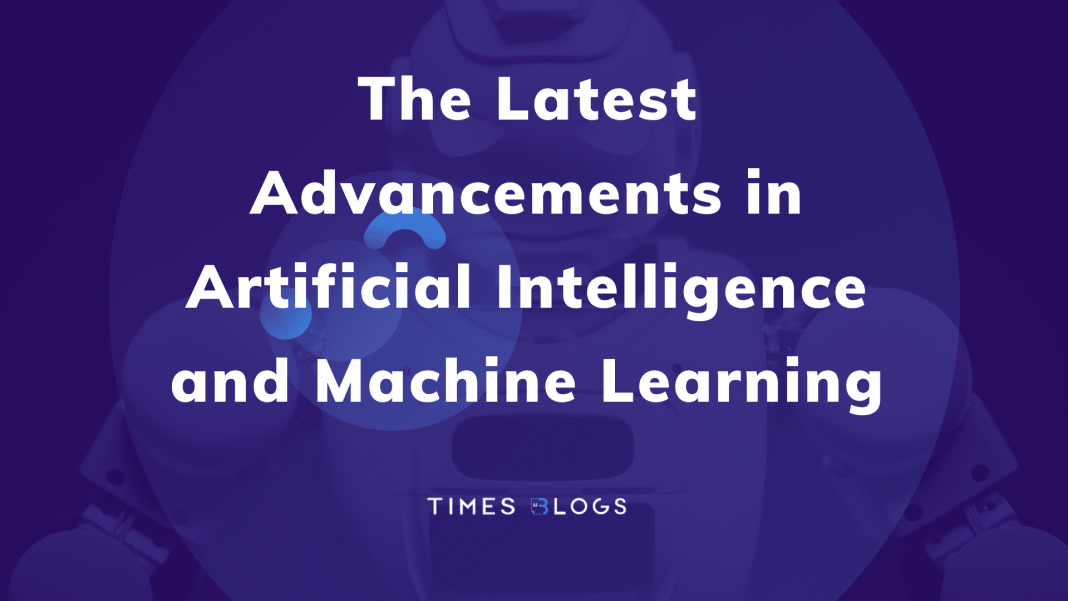Artificial Intelligence (AI) and Machine Learning (ML) are two of the most popular fields in computer science that have experienced tremendous growth over the past decade. In recent years, we have witnessed remarkable advancements in AI and ML, which have impacted various industries such as healthcare, finance, transportation, and more. This blog will explore some of the latest advancements in AI and ML, including their applications, benefits, and potential limitations.
1. Natural Language Processing (NLP):
Natural Language Processing (NLP) is a branch of AI that enables computers to understand, interpret, and generate human language. NLP has seen significant advancements in recent years, including the ability to understand and process more complex language structures. One of the most well-known examples of NLP is Google’s language model, BERT (Bidirectional Encoder Representations from Transformers). BERT is an AI model that can understand the context and meaning of words in a sentence, enabling it to provide more accurate search results.
Another example of NLP is OpenAI‘s GPT-3 (Generative Pre-trained Transformer 3), a language model that uses machine learning to generate human-like text. GPT-3 is capable of producing high-quality articles, essays, and even computer code. With these advancements, NLP has the potential to revolutionize communication and translation across the world.
2. Computer Vision:
Computer vision is a field of AI that enables computers to analyze and interpret images and videos. Recent advancements in computer vision have led to significant breakthroughs in various industries, including healthcare, automotive, and security. For instance, AI-powered computer vision systems can detect abnormalities in medical images such as X-rays and MRIs, allowing doctors to diagnose and treat diseases more accurately.
One notable example of computer vision is Tesla’s Autopilot system, which uses AI to analyze and interpret data from cameras, sensors, and other sources to enable semi-autonomous driving. The system can detect objects such as cars, pedestrians, and traffic signals, allowing the vehicle to make informed decisions and avoid accidents.
3. Generative Adversarial Networks (GANs):
Generative Adversarial Networks (GANs) are a type of neural network that consists of two parts: a generator and a discriminator. The generator creates new data based on input data, while the discriminator tries to distinguish between the generated data and real data. Over time, the generator becomes better at creating realistic data, and the discriminator becomes better at identifying fake data.
GANs have seen significant advancements in recent years, including the ability to generate high-quality images, videos, and even audio. For example, researchers at NVIDIA have developed a GAN-based system called StyleGAN, which can generate photorealistic images of people that are almost indistinguishable from real photos. This technology has potential applications in the film, gaming, and advertising industries.
4. Reinforcement Learning:
Reinforcement learning is a type of machine learning that involves an agent learning to make decisions in an environment to maximize a reward signal. The agent interacts with the environment by taking actions, and receives feedback in the form of a reward signal. Over time, the agent learns to take actions that maximize the reward signal.
One of the most significant advancements in reinforcement learning is the development of AlphaGo, an AI system developed by Google’s DeepMind. AlphaGo is a deep neural network that can play the game of Go, one of the most complex board games in the world. AlphaGo defeated the world champion at Go in 2016, demonstrating the potential of reinforcement learning in solving complex problems.
5. Explainable AI:
Explainable AI is an emerging field of AI that aims to make AI more transparent and understandable. As AI becomes more prevalent in our lives, it is essential that we understand how it makes decisions and the factors that influence those decisions. Explainable AI enables users to understand the reasoning behind an AI’s decision-making process, making it easier to detect biases and errors.
One example of explainable AI is IBM’s AI Fairness 360, an open-source toolkit that enables developers to detect and mitigate bias in machine learning models. Another example is Google’s TCAV (Testing with Concept Activation Vectors), a method that enables researchers to test and evaluate the interpretability of deep learning models.
6. Edge Computing:
Edge computing is a type of computing that brings processing and data storage closer to the devices that use them, rather than relying on centralized data centers. The goal of edge computing is to reduce latency and increase the speed of data processing, making it possible to process data in real-time.
AI and machine learning can benefit greatly from edge computing, as it allows for faster and more efficient processing of data. For example, a self-driving car can use edge computing to process data from its sensors and make real-time decisions without relying on a centralized data center.
One example of edge computing in action is Amazon’s AWS Greengrass, a service that enables developers to run AWS Lambda functions locally on edge devices, such as IoT devices. This allows for faster and more efficient processing of data, making it easier to build intelligent applications that can operate in real-time.
7. Autonomous Systems:
Autonomous systems are systems that can operate without human intervention. These systems include self-driving cars, drones, and robots, and they rely on AI and machine learning to make decisions and carry out tasks.
One of the most significant advancements in autonomous systems is the development of self-driving cars. Companies like Tesla, Waymo, and Uber are developing autonomous vehicles that can operate without human intervention. These vehicles rely on sensors, cameras, and machine learning algorithms to navigate roads and avoid obstacles.
Another example of autonomous systems is drones. Drones are being used in various industries, including agriculture, transportation, and entertainment. Drones rely on AI and machine learning to navigate their surroundings and carry out tasks, such as delivering packages or taking aerial photographs.
8. Quantum Computing:
Quantum computing is a type of computing that relies on quantum mechanics to perform operations. Quantum computers can perform calculations much faster than traditional computers, making it possible to solve complex problems that would be impossible to solve with traditional computers.
AI and machine learning can benefit greatly from quantum computing, as it allows for faster and more efficient processing of data. For example, quantum computing can be used to train machine learning models much faster than traditional computing.
One example of quantum computing in action is IBM’s Q System One, a quantum computer designed for commercial use. This computer is being used to develop new applications for AI and machine learning, such as quantum machine learning and quantum chemistry.
9. Federated Learning:
Federated learning is a distributed machine learning approach that allows multiple devices to work together to build a shared machine learning model. The devices collaborate to train the model without sharing their data with each other, preserving privacy and security.
Federated learning is becoming increasingly popular in industries where data privacy is critical, such as healthcare and finance. For example, Google is using federated learning to improve its keyboard app’s language model without storing user data on its servers.
10. Transfer Learning:
Transfer learning is a machine learning technique that involves transferring knowledge from one task to another. In transfer learning, a model that has already been trained on a large dataset is reused to perform a different but related task.
Transfer learning is beneficial when there is a limited amount of data available for training a new model. For example, a model trained to recognize dogs can be used to identify cats, even though it has never been trained on cat images before.
Transfer learning has many practical applications, such as image recognition and natural language processing. For instance, OpenAI’s GPT-3, a language model that can perform a wide range of natural language tasks, was trained using transfer learning on a massive dataset of text.
11. Neuromorphic Computing:
Neuromorphic computing is a type of computing that mimics the structure and function of the human brain. Neuromorphic systems use artificial neural networks to process data, allowing for efficient and robust processing of large amounts of data.
Neuromorphic computing is still in its early stages of development, but it has the potential to revolutionize AI and machine learning. Neuromorphic systems could be used to develop intelligent systems that can learn from experience and adapt to new situations.
One example of neuromorphic computing in action is IBM’s TrueNorth chip, which is designed to mimic the structure and function of the human brain. The TrueNorth chip is being used to develop intelligent systems, such as self-driving cars and drones.
12. Augmented Analytics:
Augmented analytics is an approach to analytics that combines machine learning and natural language processing to automate data preparation, insight discovery, and data visualization. Augmented analytics enables business users to gain insights from data without the need for specialized data analysis skills.
Augmented analytics has the potential to revolutionize the way organizations use data to make decisions. With augmented analytics, organizations can quickly and easily uncover insights from their data, allowing them to make data-driven decisions more efficiently.
One example of augmented analytics in action is Microsoft’s Power BI, a business analytics service that enables users to visualize and analyze data using natural language queries. Power BI uses machine learning algorithms to identify insights and generate data visualizations automatically.
Conclusion
AI and machine learning are rapidly evolving fields that are impacting various industries and changing the way we live and work. The advancements discussed in this blog, including natural language processing, computer vision, GANs, reinforcement learning, explainable AI, edge computing, autonomous systems, and quantum computing, have the potential to revolutionize the way we use technology and solve complex problems. However, these advancements also come with potential limitations, such as privacy concerns and ethical issues. It is essential that we continue to develop AI and machine learning in a responsible and ethical manner to ensure that they benefit society as a whole.




